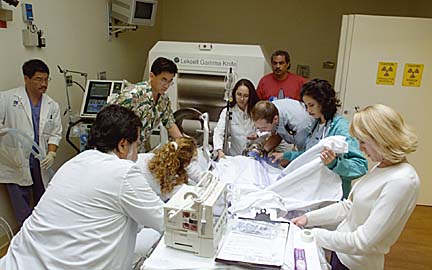


|
Isle hospitals A 3-year-old child with a life-threatening brain disorder has a chance of playing baseball again because of two Hawaii hospitals and a revolutionary nonsurgical procedure.
pitch in to save
toddler’s life
Tripler and St. Francis physicians help
the boy recover from a brain disorderBy Helen Altonn
haltonn@starbulletin.comBaseball is Inny Mareko's favorite sport, said his father, Fagasa Mareko of American Samoa. "He can hit, he can run. He always wants to slide three feet apart from the home plate."
So, Mareko said he was shocked when his son became ill on Feb. 7 and a CAT scan revealed the youngest of his five children had an abnormal cluster of blood vessels in his brain, called arteriovenous malformation.
The blood vessels had bled into the brain and caused a stroke.
The Gamma Knife Center of the Pacific at St. Francis Medical Center joined with Tripler Army Medical Center to help the child when surgery appeared risky and his family could not pay for the Gamma Knife procedure.

|
He was treated yesterday with the radiosurgical device, which is not a knife, but attacks tumors with 201 sources of precisely focused radioactive cobalt 60."I anticipate he'll come out of it fine," said Dr. Maurice Nicholson, medical director of the Gamma Knife Center. The child was transferred to Tripler where he was reported "doing great" this morning, said Lisa Capps, Gamma Knife operations manager.
He wanted to eat first thing when he woke up about 9 last night, Capps said.
He couldn't have any solid food because of possible nausea and vomiting from the anesthetic, so he was given some popsicle and he watched cartoons, she said.
"Before Gamma Knife, people with lesions too risky to operate on just had to take their chances," Nicholson said, noting all neurosurgeons on Oahu except two are using it.
Although it takes an average of two years for the treatment to obliterate a condition such as Inny's, there is some evidence that the rate of re-bleeding goes down after six months, he said.
Inny's disorder happened "spontaneously" while at school on Feb. 7, his father said. He was crying and wanted to go home, where he collapsed.
Mareko said he thought it was food poisoning, but "the doctor told me after the CAT scan he had bleeding ... so deep inside in back of the brain, he cannot do anything."
Luckily, they were able to fly here the next day, a Friday, when American Samoa's second flight of the week to Hawaii is scheduled, Mareko said. "They (doctors) told me it was a miracle we made it here."
Donating their services were Tripler Army Maj. Daniel Donovan, a neurosurgeon; Dr. Shantha McKinlay, a civilian anesthesiologist at Tripler; Dr. Winlove Suasin, St. Francis radiation oncologist; and Dr. Holmes, neuro-radiologist at the Gamma Knife Center.
"Over time, Gamma Knife rays will make the lining of the blood vessels grow thicker so that blood will no longer be able to go through them," Donovan explained. "Without any type of treatment, he'd be at risk his whole life for repeated hemorrhage and stroke."
No incisions are involved with Gamma Knife, and general anesthesia is not needed except for small children.
The procedure usually takes about half a day, and the patient can resume normal activities the next day. But treatment planning is complicated and takes a long time, Nicholson said.
Mareko, a Department of Education administrator, said Inny was not scared except when he saw a lot of doctors coming into the room, "because of the poking and needles.
"So when they came in, he played dead, sleepy, so they couldn't talk to him."
Mareko is staying in Waipahu with his niece Arlene Mareko. The child's grandmother Faiisealosa Mareko also came from Anchorage, Alaska, to be with them. Inny's mother, Sita, a high school teacher, remained home with his four brothers and sisters. She also is expecting another child.